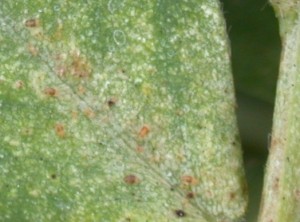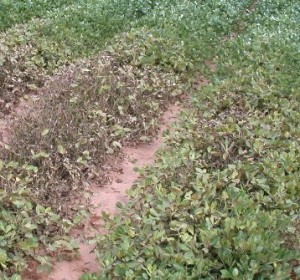Spider mite populations increase rapidly, treatments required
Numerous peanut fields in the region are seeing treatable infestations of spider mites. In the Terry and Yoakum Counties IPM scouting program, these fields have been Virginia and Runner market type peanuts, however later Spanish and Valencia fields would not be immune to infestations. Manda Anderson, Extension Agent IPM in Gaines County, reported infestations in the August 27 issue of the Gaines County IPM Newsletter.
Infestations often start near field margins, weedy areas or on the windward side of the field. Spider mites are carried in the wind by a balloon of webbing. Infestations tent to reoccur in the same areas of a field from one year to the next as mites overwinter in crop residue.
During hot, dry conditions, spider mites can complete their life cycle in as short as one week; females may live two to four weeks and are capable of laying several hundred eggs. In addition to hot, dry conditions, stressed plants and insecticide applications can result in an increase in the mite population. Broad spectrum, non-specific insecticide applications which kill beneficial insects (predators) allow for a potential explosion of the mite population.
There are several species of spider mites which can infest Texas peanuts. Spider mites have piercing and sucking mouth parts, kind of like a drinking straw. They feed by sucking the cell contents out of plants cells, which results in a “bleaching” or speckled appearance of the foliage (Figure 1). This speckling gives the infested foliage, a pale yellow appearance. Mites usually inhabit the underside of leaves, but will move to the upper surface as the population’s size increases. Usually these pests are kept in check by natural enemies; however their populations can out pace predators under favorable conditions.
Spider mite damage in the field resembles wilting, or droughty plants from a distance. When you examine the foliage more closely, you find the speckling of the leaves which results from their feeding. Extensive feeding results in defoliation (Figure 2), a lack of pod filling and death of the peanut vines. These mites are 0.4 to 0.5 mm in size, so a hand lens is helpful when confirming their presence.
There is no specific treatment threshold for spider mite infestations. One should consider the extent of the infestation, the growth stage of the cop, extend/potential of damage if mites are not controlled and the impact of control measures on beneficial insects and potential secondary pests. Before deciding to treat any spider mite infestation, take time to consider the impact of the insecticide application on beneficial insects and the potential for secondary pest out breaks. Removal of the beneficial insects and mites (some mite species are predators) will allow a release of minor pests which can become problematic. It is suggested that one monitor the mite infestation for several days to determine if it is increasing or if beneficial insects may be working to reduce the mite population.
Registered products for controlling spider mites in peanuts include Danitol, Comite and Brigade. For rates of each product consult the current product label. Thorough coverage of the canopy is essential to control an infestation. Often it can take two applications to satisfactorily control spider mites, as labeled miticides do not kill mite eggs, only adults.
Table 1. Products labeled for spider mite control in peanut (click table to enlarge).
If conditions favorable for the mites continue, eggs hatch and the population rebounds in just a few days, which may necessitate an additional chemical application. Although current conditions may prove less favorable than conditions over the previous several weeks (lower temperatures, potential rainfall). Spider mites are at a high risk of developing resistance to miticides, therefore judicious use is encouraged.
Figure 1. Spider mites are tiny relatives of ticks. Look on the underside of leaves for the actual mites. Note the speckling of the leaf caused by the feeding of these mites.
Figure 2. Heavy infestations of spider mites are capable of defoliating a peanut crop. Spotty infestations may appear as a small location on just one or two rows. If chemical treatment is required one must insure thorough coverage of the foliage.



